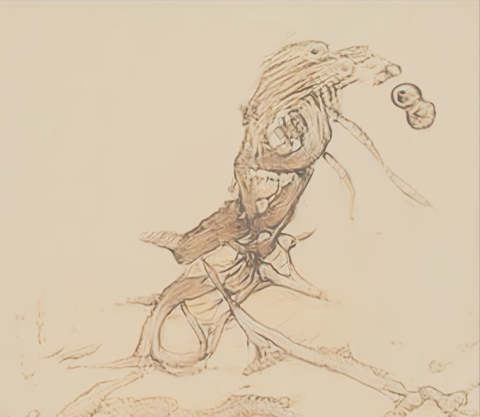London–born, New York–based artist Matthew Ritchie creates expansive looping, swirling gestural marks in drawings, paintings, sculptures, light boxes, and projections that appear on walls, spill onto floors, and hang midair. Ritchie’s multimedia, multipartite installations draw from his overarching interest in information, particularly as it is amassed by humans in an attempt to comprehend the universe and the various systems—religion, science, philosophy, and nature–they have created or drawn from. This investigational approach to creating art extends to its execution, as Ritchie’s process is collaborative, not only with people but also with machines as facilitators and, in some instances, generators. His embrace of new media began as early as 1996, when he produced his first interactive piece, The Hard Way. It used äda'web, a net art platform that enabled viewers to navigate through a narrative by following avatars based on human personality traits.
Although Ritchie leans into technology, he has asserted that drawing is central to his practice. The human trace serves as a way to give form to intangible, ephemeral ideas and to process the connections and contradictions between seemingly disparate realms of understanding. To expand his use of the gesture, he also scanned his illustrations into the computer, where he can enlarge, reduce, deconstruct, and manipulate his marks in a variety of ways. For Ritchie, drawing is an “infinite machine” with limitless possibilities for its creation and execution. Therefore, he gravitated to GAN (generative adversarial networks), another “infinite machine” of artificial intelligence programs that can endlessly generate imagery, not unlike the human creative process.
A machine-learning model, GAN is designed to imitate the structure and function of the human brain using networks called the generator and the discriminator. The generator makes millions of images, and the discriminator chooses from them. In 2020, during the pandemic, Ritchie reviewed and fed 400,000 images of medieval manuscripts, Old Master drawings, and botanical illustrations from the collection of the Metropolitan Museum of Art into GAN, which treated those images as data for the development of new images. This continual generation of forms is the basis and beauty of Ritchie’s video Caudex (2022).
The part of a plant comprising the root and stem is the caudex, where DNA develops and new growth arises. Accordingly, the video features ever-morphing drawings of plantlike forms that appear to grow and develop into others. Having been generated from an array of historical drawings, the imagery has the aged quality of a thirteenth-century volume. In fact, the title also alludes to codex, an ancient book form, as well as codec, software that encodes and decodes data, indicating the video’s melding of historical art and twenty-first-century computing. While the imagery is sometimes faint, it can also be detailed and intricate, momentarily resembling pods, roots, stems, leaves, fungi, and branches. Curving, twisting, and expanding across the screen, the drawings become familiar then quickly appear foreign, continually emerging from and collapsing into one after the other.
Furthering the haunting effect of these mutations, Caudex features an evocative choral soundtrack performed by Shara Nova with lyrics written by the artist using AI. The music was written for Infinite Movement, an opera Ritchie debuted at the University of North Texas in 2021 that imagines a duel between the discriminator and generator networks of GAN. Throughout the piece, human voices not only sing lyrics but also emulate sounds from nature–animals, insects, and weather conditions—as GAN imitates the human creative process, producing imagery that alludes to the natural world. Ritchie has stated, “Nature is everywhere, even in mathematics.” Rather than the downfall of human ingenuity or the ruination of the environment, Caudex therefore suggests humans, machines, and nature are entwined in a generative relationship, wherein they aid and foster one another. Perhaps the ghost in this machine is one to accept, rather than fear. —Kanitra Fletcher

